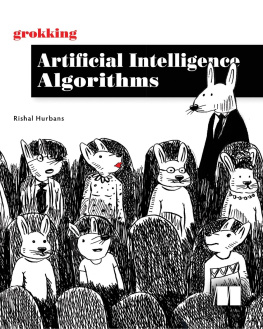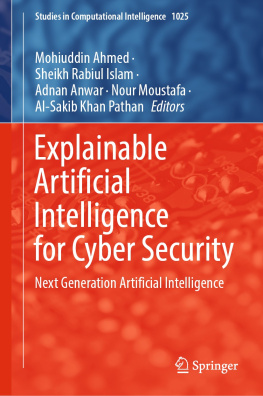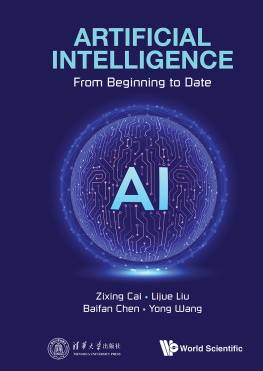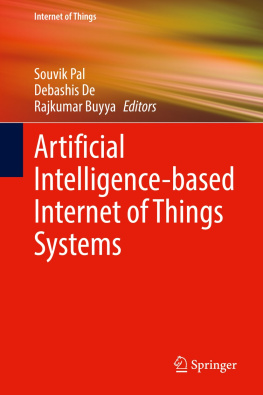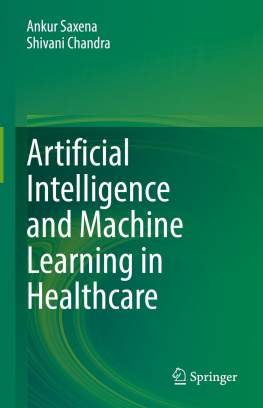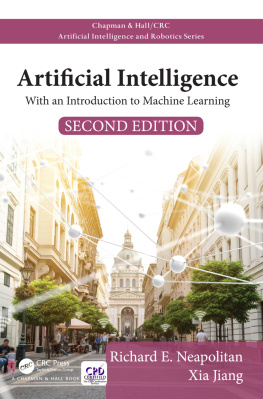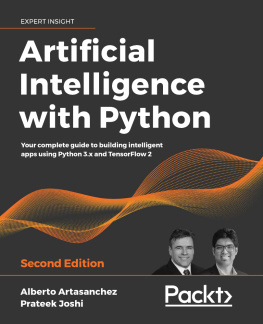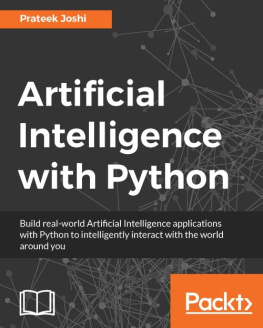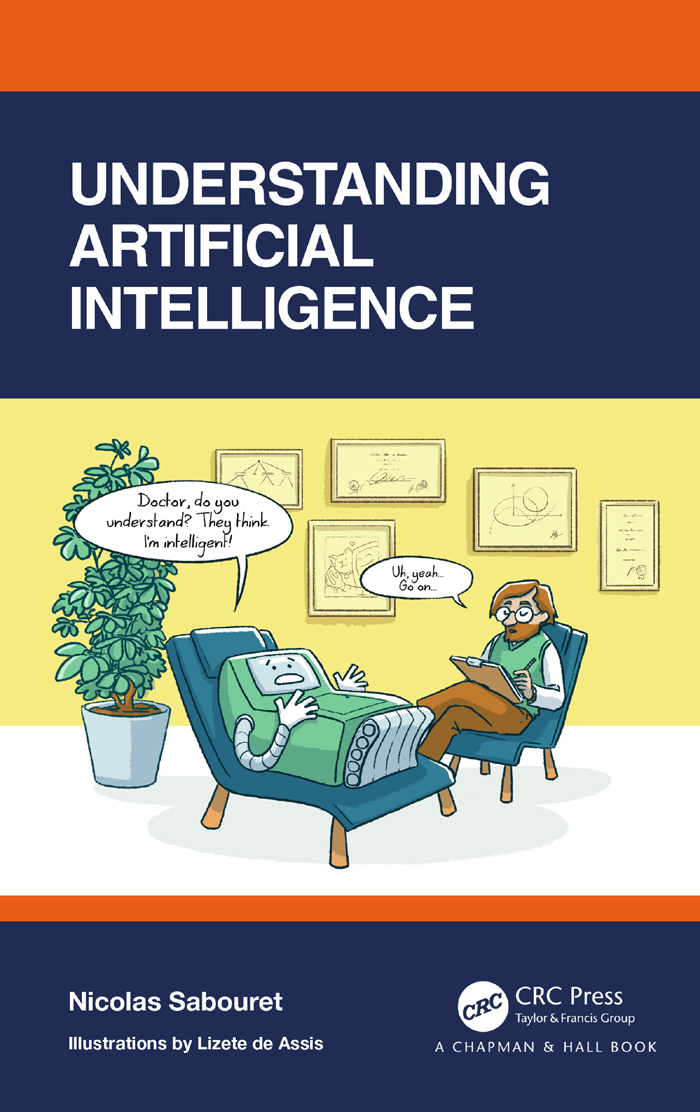Contents
UNDERSTANDING ARTIFICIAL
INTELLIGENCE
Table of Contents
UNDERSTANDING
ARTIFICIAL
INTELLIGENCE
Nicolas Sabouret
Illustrations by Lizete De Assis
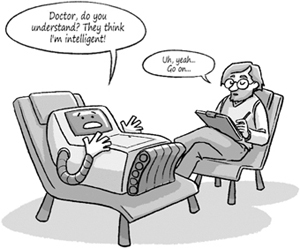

Comprendre lintelligence artificielle published by Ellipses Copyright 2019, Edition Marketing S.A.
First Edition published 2021
by CRC Press
6000 Broken Sound Parkway NW, Suite 300, Boca Raton, FL 33487-2742
and by CRC Press
2 Park Square, Milton Park, Abingdon, Oxon, OX14 4RN
2021 Taylor & Francis Group, LLC
CRC Press is an imprint of Taylor & Francis Group, LLC
Reasonable efforts have been made to publish reliable data and information, but the author and publisher cannot assume responsibility for the validity of all materials or the consequences of their use. The authors and publishers have attempted to trace the copyright holders of all material reproduced in this publication and apologize to copyright holders if permission to publish in this form has not been obtained. If any copyright material has not been acknowledged please write and let us know so we may rectify in any future reprint.
Except as permitted under U.S. Copyright Law, no part of this book may be reprinted, reproduced, transmitted, or utilized in any form by any electronic, mechanical, or other means, now known or hereafter invented, including photocopying, microfilming, and recording, or in any information storage or retrieval system, without written permission from the publishers.
For permission to photocopy or use material electronically from this work, access
Trademark notice: Product or corporate names may be trademarks or registered trademarks and are used only for identification and explanation without intent to infringe.
ISBN: 978-0-367-53136-2 (hbk)
ISBN: 978-0-367-52435-7 (pbk)
ISBN: 978-1-003-08062-6 (ebk)
Typeset in Times New Roman
by MPS Limited, Dehradun
To Chuck, with all my friendship.
Humans have never stopped inventing tools. During prehistoric times, we cut stones and made harpoons for hunting. At the dawn of agriculture, we invented pickaxes and sickles for farming, carts to transport heavy loads, and even tools to make other tools! Over time, they became more and more complex.
And then we invented machines.
The first were the cranes of antiquity. More than simple tools, machines transform energy to accomplish tasks that humans would otherwise have difficulty completing. The car, the washing machine, the lawn mower: we couldnt live without these inventions anymore.
Artificial intelligence is sometimes presented as a new revolution. It seems possible to provide machines with self-awareness, to make them capable of thinking for themselves, even to surpass us. This is a fascinating perspective, but its also troubling. This is why each advancement in artificial intelligence gives rise to all sorts of fantasies.
Our ancestors certainly had the same reaction a mix of fear and nervous enthusiasm when the first weaving looms appeared during the Renaissance. These machines were capable of doing work that, up to that point, could only be done by humans. Suddenly, a human was replaced by a human creation. Some people considered it the devils machine, while others looked at it and saw a future where no one would have to work any longer. Clothing would make itself! History has shown that the truth is somewhere in between.
In 2016, many people were left in awe as AlphaGo, Googles artificial intelligence program, beat Lee Sedol at the game Go. The program even went so far as to make a move no human player would ever have thought of. We had built a machine capable of surpassing humans on their preferred terrain: strategic thought.
So what? Are we surprised if a car beats Usain Bolt in the 100-m dash? Humans have always tried to go beyond their limits. Artificial intelligence is simply a tool to do so. This is why we urgently need to demystify what AI means for us.
AI has very little to do with the way its portrayed in science fiction novels. It is nothing like human intelligence, and there is no secret plan to replace us and enslave humanity. It is simply a tool, one of the best we have ever invented, but it has no will of its own.
AI is an incredible force that is changing the world we live in. But just as with any tool created by man, one must learn how to use it and guard against misuse. To do so, we must understand artificial intelligence. That is the goal of this book: I want to take you on a walk in the land of AI. I want to share my amazement at this extraordinary tool with you.
However, I also want to help you understand how AI works and what its limitations are.

What is artificial intelligence? Before we start debating whether machines could enslave humans and raise them on farms like cattle, perhaps we should ask ourselves what AI is made of. Lets be clear: artificial intelligence is not about making computers intelligent. Computers are still machines. They simply do what we ask of them, nothing more.
To understand what a computer is and isnt capable of, one must first understand what computer science is. Lets start there.
Computer science is the science of processing information. Its about building, creating, and inventing machines that automatically process all kinds of information, from numbers to text, images, or video.
This started with the calculating machine. Here, the information consists of numbers and arithmetic operations. For example:
346+78=?
Then, as it was with prehistoric tools, there were advancements over time, and the information processed became more and more complex. First it was numbers, then words, then images, then sound. Today, we know how to make machines that listen to what we say to them (this is the information) and turn it into a concrete action. For example, when you ask your iPhone: Siri, tell me what time my doctors appointment is, the computer is the machine that processes this information.
To process the information, the computer applies a method called an algorithm. Lets try to understand what this is about.
When you went to elementary school, you learned addition: you have to put the numbers in columns, with the digits correctly aligned. Then, you calculate the sum of the units. If there is a carried number, you make note of it and then you add the tens, and so on.
11346+78=424
This method is an algorithm.
The algorithms are like cooking recipes for mathematicians: crack open the eggs, put them in the bowl, mix, pour in the frying pan, and so on. Its the same thing. Like writing an omelet recipe for a cookbook, you can write an algorithm to describe how to process information. For example, to do addition, we can learn addition algorithms and apply them.
When building a calculator, engineers turn these algorithms into a set of electronic wires. We obtain a machine capable, when provided with two numbers, of calculating and displaying the resulting sum. These three notions (the cooking recipe, the algorithm, and the electronic machine applying the algorithm) vary in complexity, but they are well understood: a cook knows how to write and follow a recipe; a computer scientist knows how to write an algorithm; an electrical engineer knows how to build a calculator.



